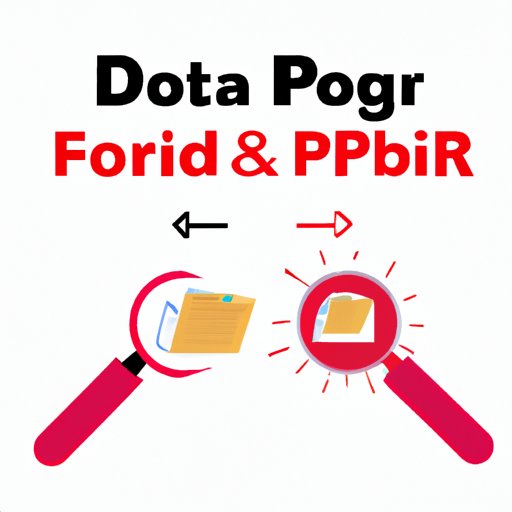
I. Introduction
Have you ever had trouble finding information in a PDF document because it wasn’t searchable? It’s frustrating and time-consuming to have to scroll through pages of text to find what you’re looking for. Fortunately, there are several ways to make PDFs searchable, and we’re here to guide you through each step. In this article, we’ll cover conversion tools, OCR vs. non-OCR, structured data, tips and tricks, and even DIY solutions for those on a tight budget. By the end of this article, you’ll be able to make any PDF document searchable with ease.
II. How-to Guide
The first step in making any PDF searchable is to use a software or app that allows for text recognition. Adobe Acrobat Pro and ABBYY FineReader are two popular choices for converting non-searchable PDFs into searchable ones. Once you have one of these programs, the steps are fairly straightforward:
- Open the PDF document in your conversion software.
- Choose the “recognize text” or “OCR” option.
- Select the language of the document.
- Wait for the software to analyze and recognize the text in the PDF.
- Save the PDF with the recognized text.
It’s important to note that some PDFs may not be compatible with text recognition software due to low resolution or poor text quality. In these cases, it may be necessary to manually edit the PDF or use alternative conversion tools.
III. Conversion Tools
There are several free and paid conversion tools available for making PDFs searchable.
- Adobe Acrobat Pro DC: This is the most popular PDF editor that offers OCR as a built-in feature. It is available through a monthly subscription fee and has a user-friendly interface.
- ABBYY Finereader: ABBYY Finereader is a paid software that allows for batch processing of PDFs to make them searchable, and has advanced recognition features such as table recognition.
- PDF-XChange Editor: This is a free software that includes OCR capabilities, as well as basic editing and annotation tools.
- DocuPub: DocuPub offers both an online tool and a desktop application for converting PDFs to searchable format. The online tool is free, while the desktop application requires a fee.
Before committing to any one tool, it’s important to research their features and benefits to ensure they meet your specific needs and requirements.
IV. OCR vs. Non-OCR
Before deciding on which PDF to use, it’s important to understand the differences between OCR and non-OCR PDFs.
A non-OCR PDF is essentially a scanned image of a document, and is not searchable. OCR, on the other hand, is a software technology that converts scanned text into editable text. OCR PDFs are searchable and can be edited.
The main benefit of non-OCR PDFs is that they maintain the original document’s layout and design, while OCR PDFs may experience minor changes in formatting. However, non-OCR PDFs are not searchable, making them less useful for information retrieval purposes. In general, OCR PDFs are recommended for their increased utility and ease of use.
V. Structured Data
Structured data is important for making PDFs more searchable. It involves using specific metadata and tags to organize data within the PDF document. By structuring data, you can significantly improve search accuracy and efficiency.
Some examples of structured data include:
- Adding keywords to the document properties
- Using standardized file naming conventions
- Adding descriptive alt tags to images
- Using headings and subheadings
By taking the time to structure data within your PDF documents, you’ll be able to streamline the search process and find information more quickly and easily.
VI. Tips and Tricks
Here are some tips and tricks for making your PDFs more searchable:
- Use clear and concise language in the document
- Optimize images for search (e.g., compressing large files)
- Use consistent formatting throughout the document (e.g., title, subtitles, and headings)
- Make sure the text is properly aligned with the layout of the document
- Edit the PDF to remove any extraneous or unnecessary content
VII. DIY Solutions
If you’re looking to make your PDFs searchable without purchasing additional software, you can use Adobe Acrobat Pro or Google Drive.
Adobe Acrobat Pro:
- Open the PDF in Adobe Acrobat Pro.
- Select “Tools” from the main menu.
- Select “Enhance Scans” from the dropdown menu.
- Choose “Recognize Text” from the options provided.
- Select “In this file” to recognize text in the entire document.
- Click “OK” to start the text recognition process.
- Save the PDF with the recognized text.
Google Drive:
- Upload the PDF to your Google Drive account.
- Right-click on the PDF and select “Open with Google Docs.”
- Wait for the file to convert to Google Doc format.
- Press “Ctrl” + “F” to bring up the search bar and search for specific terms.
While these DIY solutions may not be as full-featured as professional software, they offer an accessible and cost-effective alternative for those on a tight budget.
VIII. Conclusion
Making PDFs searchable is an essential task for anyone who regularly works with documents. By following the steps outlined in this article, you’ll be able to convert non-searchable PDF documents into fully searchable ones. Whether you use conversion software or opt for a DIY solution, you can easily improve search efficiency and accuracy. By keeping structured data in mind, optimizing images, and formatting your PDFs consistently, you’ll be able to create PDF documents that are a breeze to search through, saving you time and frustration in the process.





